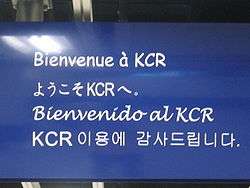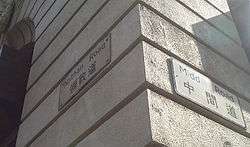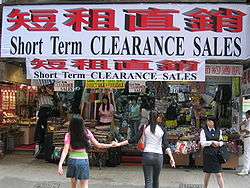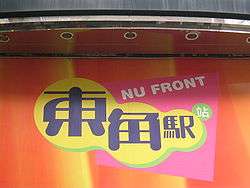Languages of Hong Kong
The Basic Law of Hong Kong states that English and Chinese are the two official languages of Hong Kong.[1] During the British colonial era, English was the sole official language until 1978 but remain as a strong second language in Hong Kong. As the majority of the population in Hong Kong are descendants of migrants from China's Canton Province, the vast majority speak standard Cantonese or other Yue Chinese varieties as a first language, with smaller numbers of speakers of Hakka Language or the Teochew dialect of Southern Min. In addition, immigrants and expatriates from the West and other Asian countries have contributed much to Hong Kong's linguistic and demographic diversity. The geographical element of this diversity can be seen in the Hong Kong Language Maps.[2] Statistics for the 27 self-reported spoken languages/dialects reported in the 2011 Census, can be found in the report: Language Use, Proficiency and Attitudes in Hong Kong[3]
Official languages
Chinese and English are both official languages of Hong Kong under the Hong Kong Basic Law (article 9) and the Official Languages Ordinance (chapter 5 of the Laws of Hong Kong). No law stipulates choice of spoken Chinese dialect.
English was the sole official language of Hong Kong from 1883 to 1974. Only after demonstrations and petitions from Hong Kong people demanding equal status for Chinese[6] did the language become official in Hong Kong from 1974 onward. Annex I of the 1984 Sino-British Joint Declaration provided that English may be used in addition to Chinese for official purposes in the future Hong Kong special administrative region. In March 1987, the Official Languages Ordinance was amended to require all new legislation to be enacted bilingually in both English and Chinese. In 1990, the Hong Kong Basic Law affirmed English's co-official language status with Chinese after the 1997 handover.
Chinese
As a result of immigration into Hong Kong from Canton Province, Cantonese is the dominant Chinese variant spoken in the territory with smaller numbers of speakers from other dialects. There are also numerous Chinese languages spoken by the native peoples of the New Territories, many of which are mutually unintelligible. Cantonese is a vernacular, and when reduced to writing it is normally converted to a standard written Chinese quite dissimilar to the spoken word.
There is also a written language based on the vocabulary and grammar of spoken Cantonese known as written Cantonese. Although the "biliterate and trilingual" policy implies an absence of support for written Cantonese, it has gained popularity in news media where entertainment and local news are related. Written Cantonese is unintelligible to non-Cantonese speakers and is considered nonstandard by educators despite its widespread usage in Hong Kong. Some have also credited written Cantonese for solving the challenges that standard written Chinese had faced in popular culture.
Traditional Chinese characters are widely used, and are the de facto writing standard in Hong Kong. Simplified Chinese is seen in some posters, leaflets, flyers and signs in the tourist areas.
Cantonese
The principal language of Hong Kong is standard Cantonese (粵語, 廣州話, 廣東話, 廣府話, 白話, 本地話),[7] spoken by 88.9% of the population at home daily. As an official language, it is used in education, broadcasting, government administration, legislation and judiciary, as well as for daily communication. As a result of its predominance throughout the community, Cantonese is virtually the exclusive language of official discourse at all levels of the executive, legislature and courts of Hong Kong.


Native Yue dialects
A few closely related dialects to standard Cantonese continue to be spoken in Hong Kong. Most notable is the Weitou dialect (圍頭話), which is mostly spoken by the older generation living in walled villages in New Territories. Additionally, the Tanka people (蜑家人/疍家人/水上人) from the fishing villages on outlying islands speak their own variant of Cantonese. However, this dialect is now largely limited to those middle aged and above.
Hakka
Hakka is indigenous to many villages in the New Territories and within Hakka communities in Hong Kong. Nowadays, outside these rural villages and older populations, younger Hakka Chinese populations communicate primarily in Cantonese.[8][9]
Minnan Chinese
Teochew, Hokkien, and Taiwanese are the Minnan (Southern Min) Chinese dialects commonly found in Hong Kong. However, their usage is largely limited to recent migrants from Taiwan or Fujian and middle aged descendants of immigrants from native Chinese regions of these variants.
Varieties of Chinese in the region
Taishanese
Taishanese originates from migrants from Taishan County in Mainland China. The variant can still be found in some areas in Hong Kong where migrants concentrated, such as Sai Wan.
Shanghainese
Shanghainese is commonly spoken by migrants who escaped Shanghai after the communist takeover of China in 1949. Their descendants seldom speak the language nowadays.
Mandarin
When Hong Kong was a colony of the United Kingdom, Mandarin Chinese (普通話/現代標準漢語/國語/北方話) was not widely used in Hong Kong. Since the 1997 Handover, the huge increase in inbound tourism from the mainland has led to much more widespread use of Mandarin, particularly in tourism-related commerce, though little impact has been seen in locally based commerce or public services. In addition, the large number of seung fei (雙非) children (children born in Hong Kong whose parents are both from the Mainland) has increased the number of Mandarin-speaking people, particularly in districts close to the border, such that Mandarin-speaking children make up large proportions or even the majority of primary-school students in those districts, causing the beginnings of a language shift in those areas.
English

English is a major working language in Hong Kong, and is widely used in commercial activities and legal matters. Although the sovereignty of Hong Kong was transferred to the PRC by the United Kingdom in 1997, English remains one of the official languages of Hong Kong as enshrined in the Basic Law.
Code-switching between Cantonese and English
Many Hong Kong people use both Cantonese and English, or "code-switch", in the same sentence when speaking. For example, "唓,都唔 make sense!" ("Wow, it does not make sense!"). The code-switching can freely mix English words and Chinese grammar, for instance "你 un 唔 understand?" ("Do you understand?") which follows the Chinese grammar syntax 'verb - not - verb' to ask "Do you (verb)?".
Some code-switched words are used so often that they have become loanwords in Cantonese,[10] for example,
- "like", pronounced "lai-kee" /laːi55kʰi35/.
- "Partner", pronounced "pat-la" /pʰaːt̚55laː21/.
- "File", pronounced "fai-lo" /faːi55lou35/.
- "Number", pronounced "lum-ba" /lɐm55pa35/.
- "Case", pronounced "kei-see" /kʰei55si35/.
Other European languages
French
In Hong Kong, French is the second most studied foreign language after Japanese. Many institutions in Hong Kong, like Alliance française, provide French courses. Local universities, such as the University of Hong Kong, the Chinese University of Hong Kong and Hong Kong Baptist University, offer programmes which aim at developing proficiency in French language and culture. The language is included as a subject in the HKCEE, but not in HKALE with accordance to British International General Certificate of Secondary Education (IGCSE) standards. The IGCSE French syllabus used by the University of Cambridge Local Examinations Syndicate (UCLES) is adopted in the examination. The only French book store, Librairie Parentheses, in Hong Kong is located on Wellington Street, Central.[11]
Real estate developers in Hong Kong often give their buildings French names, such as Bel-Air, Les Saisons and Belle Mer. This kind of foreign branding is also used in boutiques and restaurants. An example is Yucca de Lac in Ma Liu Shui. Sometimes only French elements such as articles and prepositions are added to the name, as in the case of the restaurant chain Café de Coral. Similar mixing of English and French can be seen on the menu of Délifrance, a French-style restaurant chain in Hong Kong.
German
The number of German speakers in Hong Kong is about 5000, significant enough for the establishment of the German Swiss International School (Deutsch-Schweizerische Internationale Schule), which claims to number more than 1,000 students, at The Peak of Hong Kong Island.[12] Many institutions in Hong Kong provide German courses. The most well-known one is the Goethe-Institut, which is located in Wan Chai. After spending a certain period in learning German, students can take the German Test as a Foreign Language (Test Deutsch als Fremdsprache; TestDaF for short) and Start German A1-C2. There are currently two test centres for TestDaF in Hong Kong: the Goethe-Institut and the Hong Kong Baptist University. The latter one also offers a European Studies degree course of German Stream, Bachelor of Social Science in European Studies (German Stream), in parallel with the French stream. A minor program of German is offered at the Language Centre of HKBU. The Hong Kong University offers a Major in German after 4 years of study. The Chinese University offers a Minor in German and popular summer courses. The Hong Kong University of Science and Technology offers German for science and technology.
Other East Asian languages
Japanese
There are over 25,000 Japanese people in Hong Kong, so it is not uncommon to hear Japanese conversations. More than 10,000 people in Hong Kong had taken the JLPT in 2005.[13] Hong Kong-based R by R Production produces a television travel show set in Japan, which, as of April 2016, is broadcast on ViuTV. However, the language is often misused.[14]

Japanese culture, especially the popular culture, has been popular in Hong Kong for decades. Hong Kong people occasionally replace Chinese characters with Japanese. In addition, the Companies Registry also permits the hiragana の ‘no’ in Chinese business names that are registered in Hong Kong.[15] The hiragana の is usually used in place of the Chinese character 之 (zi1) and read as such in Hong Kong. In fact, Aji Ichiban has adopted の in their company name (優の良品). There are also borrowings from Japanese shinjitai kanji 駅 ‘eki’ to substitute 站 (Sidney Lau: jaam6)(both 站 and 駅 mean "station" in their respective languages), as in Nu Front (東角駅), a shopping mall for Hong Kong youngsters in Causeway Bay. There are also some private estates named with the kanji 駅. These loanwords are pronounced by Hong Kong people as if they were their Chinese counterparts (i.e. の as 之, and 駅 as 站). The Japanese 駅 is the shinjitai of the hanzi 驛 (Sidney Lau: yik6). However, 驛 has fallen out of usage to 站 in modern Chinese and became obsolete. Therefore, it is not uncommon to mispronounce 駅 as its phonetic compound 尺(Sidney Lau: chek3)).
Korean
Koreans in Hong Kong only make up a small minority while Korean culture has gained popularity since the early 2000s. Korean pop music was the first Korean media to enter Hong Kong's market. Since then, several Korean TV series such as Dae Jang Geum have been broadcast to numerous audiences.[16] There are roughly 1,000 students that took Korean courses at the Chinese University of Hong Kong each year, including undergraduates as well as professionals who enrolled in continuing education programs. Roughly 3,000 people have taken the Test of Proficiency in Korean since its introduction to Hong Kong in 2003.[17] Surveys and statistics from course enrollments have shown that nine-tenths of the students studying Korean in Hong Kong are female.[18]
Southeast Asian languages
Filipino
Filipino and other Philippine languages are used by Filipinos in Hong Kong, most of whom are employed as foreign domestic workers.
Newspapers and magazines in Filipino can also be easily bought in Central, Hong Kong. There are also a small number of churches in Hong Kong that have masses or services in Filipino, for example the afternoon masses provided by the St. John's Cathedral in Central.
Indonesian
Indonesian is the common language for the significant number of Indonesians working in Hong Kong, though Javanese is also widely spoken. Most are domestic workers; on their days off, they often gather at Victoria Park in Causeway Bay to socialise and the language can be heard.[19]
Thai
Thai prevails among the Thai population in Hong Kong, who mostly work as domestic workers. The Thai language is found in many shops and restaurants opened by Thais in Kowloon City. A number of Thai movies have been imported since the early 2000s, such as The Wheel in the medley Three, Jan Dara, the Iron Ladies, My Little Girl, and Ong-Bak: Muay Thai Warrior and Tom-Yum-Goong starring Tony Jaa.
Vietnamese
Vietnamese is used in Hong Kong among the ethnic Chinese from Vietnam who had initially settled in Vietnam and returned to Hong Kong. Vietnamese refugees who left their home during the Vietnam War are another group.
South Asian languages
In 2006, there were at least 44,744 persons of South Asian descent in Hong Kong.[20] Signboards written in Hindi or Urdu can be seen, and conversation in South Asian languages including Nepali, Sindhi and Punjabi, as well as Urdu, Hindi and Tamil can be heard.
Hong Kong has two Nepalese newspapers, The Everest and the Sunrise Weekly Hong Kong. In 2004, the Home Affairs Bureau and Metro Plus AM 1044 jointly launched radio shows Hong Kong-Pak Tonight in Urdu and Hamro Sagarmatha in Nepalese.[21]
Hindi
The history of Indians in Hong Kong can be traced back to the early days of British Hong Kong. When the Union flag of the United Kingdom was hoisted on 26 January 1841, there were around 2,700 Indian troops that participated, and they played an important role in the development of Hong Kong in the early days. The most prominent contributions were the founding of the University of Hong Kong (HKU), the Hong Kong and Shanghai Banking Corporation (HSBC) and the Star Ferry.
Although nearly all of the Indian people who live in Hong Kong speak and write Indian English, some have maintained the usage of Hindi as a second language.
Middle Eastern languages
Sign language
See also
References
- "Hong Kong Basic Law: Chapter I". Hong Kong Basic Law. Archived from the original on 23 November 2017. Retrieved 17 March 2008.
- "Hong Kong Language Maps". SSRC, HKU. Archived from the original on 13 March 2019. Retrieved 8 March 2019.
- "Language Use, Proficiency and Attitudes in Hong Kong" (PDF). SSRC, HKU. Archived (PDF) from the original on 27 March 2019. Retrieved 8 March 2019.
- "East & Southeast Asia :: HONG KONG". CIA The World Factbook. Archived from the original on 10 October 2010.
- Mair, Victor (1 July 2017). "Cantonese: Still the Native Language of Hong Kong". Language Log. Archived from the original on 4 July 2017. Retrieved 27 January 2018.
- "cu40 《中大四十年》" (in Chinese). 21 July 2011. Archived from the original on 21 July 2011. Retrieved 28 January 2018.
- "Population Aged 5 and Over by Duration of Residence in Hong Kong, Ethnicity and Usual Language, 2011 (A124)". Census2011.gov.hk. Archived from the original on 31 December 2017. Retrieved 28 January 2018.
- http://www.hkilang.org (in Chinese Traditional)
- http://podcast.rthk.hk/podcast/item_epi.php?pid=315&lang=zh-CN&id=16160 Archived 18 May 2015 at the Wayback Machine RTHK《漫遊百科 - Ep. 17》(in Cantonese)
- Chan, Mimi and Helen Kwok (1982). A Study of Lexical Borrowing from English in Hong Kong Cantonese. Hong Kong: Centre of Asian Studies, University of Hong Kong.
- "Archived copy". Archived from the original on 30 September 2007. Retrieved 26 February 2007.CS1 maint: archived copy as title (link) Librairie Parentheses, "only French bookstore"
- "Principal's Welcome". German Swiss International School. 9 December 2006. Archived from the original on 11 January 2007. Retrieved 12 January 2007.
- "Number of Applicants and Examines by Test Site of the JLPT 2005" Archived 2007-01-13 at the Wayback Machine, The Japan Foundation. Retrieved on 2007-02-25.
- "2005年10月 ニホンコンゴ★ ついに映像化!", Archived February 18, 2007, at the Wayback Machine R by R Production. Retrieved on 2007-02-25. (in Japanese)
- "Business" Required to be Registered and Application for Business Registration: Business Name Archived 1 December 2017 at the Wayback Machine, Inland Revenue Department
- "學習韓語秘技傍身" Archived 2007-09-28 at the Wayback Machine, Centaline Human Resources Consultants Limited, 2005-03-03. Retrieved on 2007-02-25. (in Traditional Chinese)
- "The Woman Who Taught Hong Kong to Speak Korean", Chosun Ilbo, 28 January 2010, archived from the original on 30 January 2010, retrieved 28 January 2010
- Kim, Hyewon Kang (2010), "Korean Language and Korean Studies in Hong Kong (1998–2009)", Electronic Journal of Foreign Language Teaching, 7 (1): 141–153, archived from the original on 14 January 2011, retrieved 15 February 2011
- "Indonesian migrant workers in Hong Kong". Radio International Singapore. 25 February 2006. Archived from the original on 28 September 2007. Retrieved 9 January 2007.
- "Thematic Report: Ethnic Minorities" (PDF). Publications and Products of the 2006 Population By-census. Census and Statistics Department, Hong Kong (xvi). 28 December 2007. Archived (PDF) from the original on 21 July 2011. Retrieved 23 January 2008.
- "Urdu and Nepali radio programmes to launch". Hong Kong Information Services Department. 19 November 2004. Archived from the original on 17 March 2005. Retrieved 12 January 2007.
- "古蘭經及阿文新課程 (Qur'an and Arabic language class)". Islam.org.hk. 3 April 2006. Archived from the original on 29 June 2006. Retrieved 12 January 2007.
Bibliography
- Bruce, Nigel (1996). Language in Hong Kong Education & Society: A Bibliography
- Pennington, Martha C. ed. (1998). Language in Hong Kong at Century's End. Hong Kong: Hong Kong University Press. ISBN 962-209-418-X.
- Dickson, Peter; Alister Cumming, eds. (1996). "HONG KONG LANGUAGE POLICY". National Profiles of Language Education in 25 Countries (PDF). Berkshire, England: National Foundation for Educational Research.
External links
- Website of Official Languages Division, Civil Service Bureau.
- The British Council, British Council of Hong Kong.
- Alliance Française, Hong Kong.
- French at The University of Hong Kong, Hong Kong
- Goethe-Institut, Hong Kong.
- HKU HK dialects website, Hong Kong.
Countries.png)